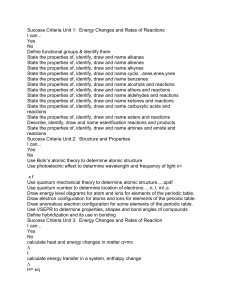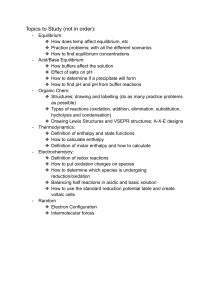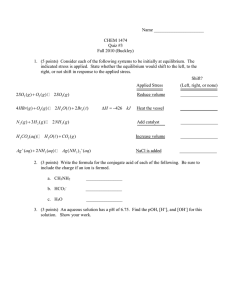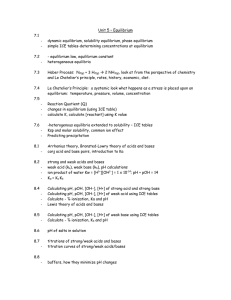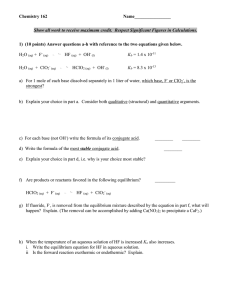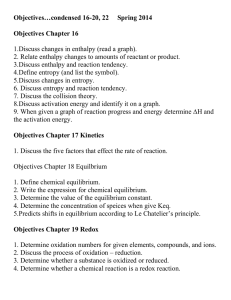SCH4C Exam Review
advertisement
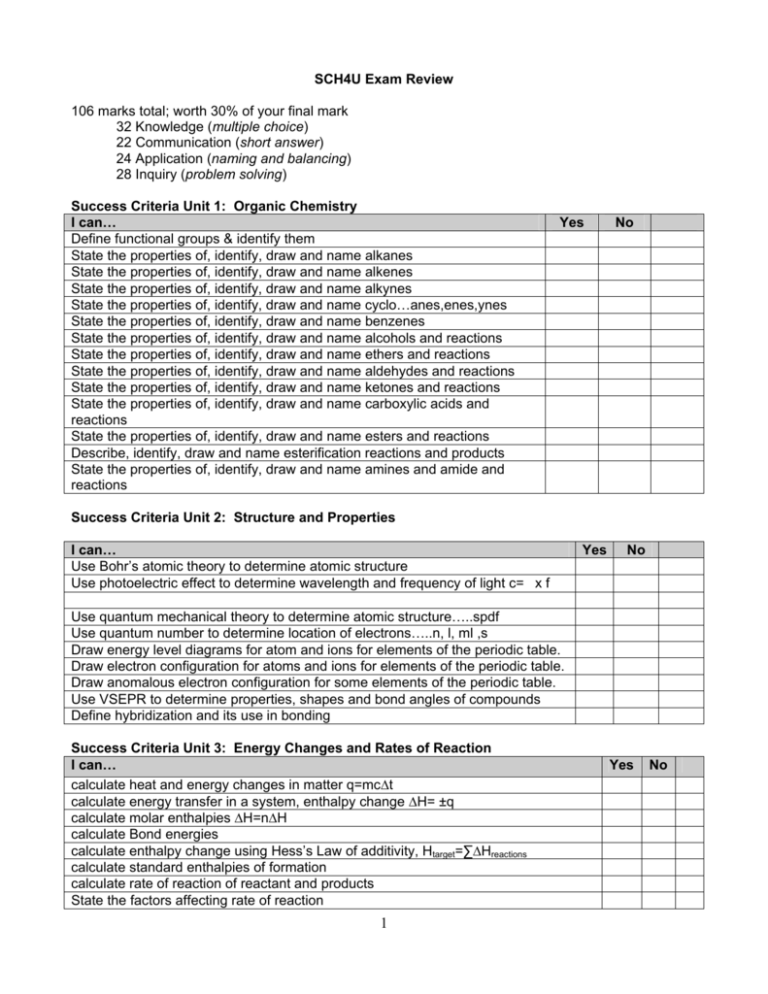
SCH4U Exam Review 106 marks total; worth 30% of your final mark 32 Knowledge (multiple choice) 22 Communication (short answer) 24 Application (naming and balancing) 28 Inquiry (problem solving) Success Criteria Unit 1: Organic Chemistry I can… Define functional groups & identify them State the properties of, identify, draw and name alkanes State the properties of, identify, draw and name alkenes State the properties of, identify, draw and name alkynes State the properties of, identify, draw and name cyclo…anes,enes,ynes State the properties of, identify, draw and name benzenes State the properties of, identify, draw and name alcohols and reactions State the properties of, identify, draw and name ethers and reactions State the properties of, identify, draw and name aldehydes and reactions State the properties of, identify, draw and name ketones and reactions State the properties of, identify, draw and name carboxylic acids and reactions State the properties of, identify, draw and name esters and reactions Describe, identify, draw and name esterification reactions and products State the properties of, identify, draw and name amines and amide and reactions Yes No Success Criteria Unit 2: Structure and Properties I can… Use Bohr’s atomic theory to determine atomic structure Use photoelectric effect to determine wavelength and frequency of light c= x f Yes No Use quantum mechanical theory to determine atomic structure…..spdf Use quantum number to determine location of electrons…..n, l, ml ,s Draw energy level diagrams for atom and ions for elements of the periodic table. Draw electron configuration for atoms and ions for elements of the periodic table. Draw anomalous electron configuration for some elements of the periodic table. Use VSEPR to determine properties, shapes and bond angles of compounds Define hybridization and its use in bonding Success Criteria Unit 3: Energy Changes and Rates of Reaction I can… calculate heat and energy changes in matter q=mc∆t calculate energy transfer in a system, enthalpy change ∆H= ±q calculate molar enthalpies ∆H=n∆H calculate Bond energies calculate enthalpy change using Hess’s Law of additivity, Htarget=∑∆Hreactions calculate standard enthalpies of formation calculate rate of reaction of reactant and products State the factors affecting rate of reaction 1 Yes No Write the rate law equation for a system. Write the rate equation for a reaction. Use the rate equation to calculate constant and the rate of reaction, Success Criteria Unit 4: Chemical Systems and equilibrium. I can… Explain an equilibrium system graphically and set an ICE table Write an equilibrium constant expression, K, for a system Do calculations involving K Determine the variables affecting chemical equilibrium Calculate the concentration of entities in equilibrium system Calculate the solubility product constant, Ksp, of a solution. Calculate the solubility using constant, Ksp, of a solution Perform a multistep calculation, including Q, to predict precipitation. Calculate pH, pOH, [H+] and [OH-] of strong acids and bases Calculate Ka, Kb, pH, pOH, [H+] and [OH-] of weak acids and bases Yes No Yes No Success Criteria Unit 5: Electrochemistry I can… Assign oxidation number to elements in molecule, ionic compound and ions Balance chemical equations using oxidation number Balance half equations Balance equations in acidic and basic solutions Predict redox reaction and develop redox table Draw a galvanic cell and write half equation. Calculate standard cell and cells potential. Tips to Succeeding on Your Exam: Review the website to make sure you have all the notes and if not, download what you are missing Ask questions during your exam review days Go back over old tests and quizzes and redo your answers Complete questions from the textbook that have been assigned Make study notes Review a little everyday instead of cramming last second Get a solid night’s sleep before your exam Eat a good breakfast the morning of your exam 2
